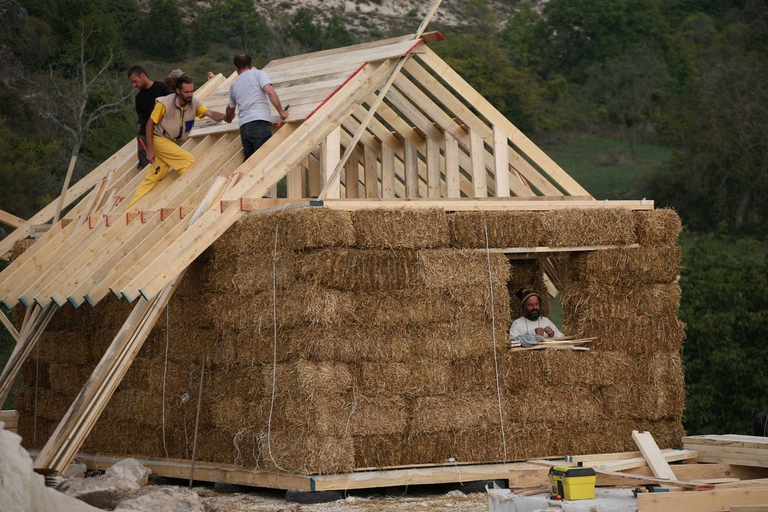
Niseko, Toya-Usu and Shiraoi are three Hokkaido destinations for travellers who want to feel close to the communities they’re visiting.
Nearly the half of the greenhouse gas emissions in the atmosphere are generated by the construction industry and buildings energy consumption. Sustainable construction techniques are necessary in order to reduce the environmental impact. Natural materials and low CO2 emissions practices are fundamental in making building more sustainable for the planet. Straw houses are appropriate examples
Nearly the half of the greenhouse gas emissions in the atmosphere are generated by the construction industry and buildings energy consumption. Sustainable construction techniques are necessary in order to reduce the environmental impact. Natural materials and low CO2 emissions practices are fundamental in making building more sustainable for the planet. Straw houses are appropriate examples of sustainable architecture.
Here’s why you should bear them in mind.
Money saving. Straw houses are economically sustainable. Construction and management costs of a straw-bale construction are way lower than a traditional building. Straw houses allow you saving about 75% of energy costs for heating and cooling systems. If buildings are designed according to bioclimatic principles, it’s even possible zeroing costs, by eliminating installations.
Integration and identity. Cities residual spaces are the drama of modern building. “Non-spaces” are places where people don’t identify themselves in; they feel isolated even if they’re living in populated neighbourhoods. In many cases, the act of constructing straw houses was a stimulus to cooperation and integration within the neighbourhood. This is why the simplicity of the assembling doesn’t imply any preparation, except for foundations and load-bearing structure that require a certification by specialized firms.
The environment. Straw-bale constructions are environmentally sustainable: the raw material is fully natural and is locally available. Moreover, once you have your straw bales, the construction is really fast, and the material can completely be recycled when no longer in use. These are few of the environmental advantages.
Straw bales are a perfect thermal insulation. The thermal transmittance, i.e. the capacity of exchanging heat, of the walls is three times better compared with traditional ones, and always guaranteeing the A band in energy performance ratings.
Comfort. Straw houses are comfortable, since the bales’ thickness (45 cm) works as sound insulator and allows the natural transpiration of walls, avoiding condensation and moulds.
Allergies-proven. Straw houses don’t develop allergies, otherwise than hay. The material is not processed during packaging and doesn’t emit any harmful substances or allergens, and the plaster made of clay is an additional guarantee.
Fire resistance. Straw houses defend from fire. The pressed straw bales contain a low rate of oxygen. German studies demonstrate a R90 resistance to fire (90 minutes of resistance to flames) of bales (without plaster), which is a higher rate compared with conventional building materials.
Earthquake protection. Straw houses are incredible earthquake-resistant buildings, according to the Network for Earthquake Engineering Simulation Laboratory of the University of Nevada. Straw houses have a load-bearing structure made of wood, which works exactly like common buildings during earthquakes, with the advantage that its lightness develops a lower acceleration.
The benefits of straw houses are several, and yet they have a few disadvantages. The use of straw doesn’t allow complex elaborations of the planimetry. For this reason, straw houses are very simple, and the wooden structure implies the construction of low buildings, which may be difficult adaptable to an urban context.
Straw constructions are really suitable in rural areas or areas where buildings construction is not developed vertically. Both cases offer plenty examples.
Straw houses are eco-friendly, sustainable, safe and economical.
However, we are not going to see a skyscraper, an airport or a stadium made of straw, until the technology will find solutions in line with the city’s lifestyle.
Siamo anche su WhatsApp. Segui il canale ufficiale LifeGate per restare aggiornata, aggiornato sulle ultime notizie e sulle nostre attività.
![]()
Quest'opera è distribuita con Licenza Creative Commons Attribuzione - Non commerciale - Non opere derivate 4.0 Internazionale.
Niseko, Toya-Usu and Shiraoi are three Hokkaido destinations for travellers who want to feel close to the communities they’re visiting.
We talked to World Happiness Summit organiser Karen Guggenheim about the connection between the planet’s health and our happiness.
The new generation of high-performance wood materials offers unexpected hi-tech possibilities to the worlds of design and architecture.
A group of experts in Tokyo suggested pouring radioactive water from Fukushima into the open sea. A marine biochemist explains the consequences of this absurd decision.
By recovering clothes discarded in the West, Togolese designer Amah Ayiv gives them new life through his high fashion creations.
All catwalks in July will be broadcast online: after Paris, it’s Milan Digital Fashion Week’s turn. And the biggest beneficiary is the environment.
Disabled travellers need not fear Japan. Accessible Japan founder Josh Grisdale tells us about his commitment to opening the country’s doors to everyone.
Kalongo Hospital in Uganda is on high alert. Medics are facing the pandemic amid an already precarious healthcare situation, in a country with only 55 intensive care beds.
Indigenous peoples in the isolated region are suffering from poor access to health, with several cities becoming hotspots of coronavirus in the Amazon. Indigenous leaders, health experts and NGOs are calling for international help.









